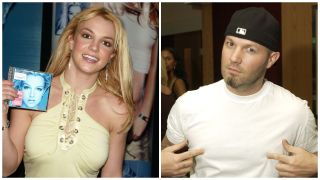If you were even loosely plugged into a) metal or b) pop culture during the early 2000s, you would have struggled to escape the media circus that surrounded Britney Spears and Fred Durst. After the Limp Bizkit frontman hinted that he and the superstar pop princess had entered into some kind of romantic relationship in a post shared on Bizkit’s official website in early 2003, lovingly describing Britney as “a person that I [wouldn’t] have thought could make me feel this way”, the media went into overdrive, badgering both parties with questions about the situation in the immediate aftermath.

Spears flatly denied the whole thing, stating on MTV’s TRL show: “there’s no relationship. I’m confused about it. I don’t really know him that well.” Durst, however, didn’t back down on his claim, calling Spears a “fucking liar” in an excruciating interview with Howard Stern soon after. Stern, clearly excited by the implications of the alleged tryst, relentlessly peppered a visibly uncomfortable Dust with lewd questions about Spears and exactly what had happened between the two, leading the rapper to state that it would be “uncool” for him to go into too much detail.
Whatever the hell happened, the media frenzy wouldn’t abate for months afterwards. Durst has stuck by his guns ever since that time, telling MTV in 2009 that he was “in no way a liar” and even referencing Britney in a crude line on Bizkit’s 2013 track, Ready To Go. Britney, on the other hand, hasn’t even acknowledged Durst since.
Regardless, the legend of Britney and Fred has never fully gone away, but one fascinating facet of it all that has seemingly been overlooked since is that the whole fiasco came about because the two had actually been working together. Yep: Britney Spears, sugar-sweet pop heroine, collaborating with nu metal’s premier bad boy and walking controversy magnet.
RECOMMENDED VIDEOS FOR YOU…
Looking for a bolder, more mature direction to firmly break her out of her ‘teen idol’ status, in late 2002 Spears would begin reaching out to a dizzying array of potential collaborators to contribute to her fourth studio album. Amongst those rumoured to have either written with Spears or at least met with the singer around this time were dance music icons Daft Punk, heavyweight producers Timbaland and William Orbit, the latter of whom had helmed Madonna’s acclaimed Ray Of Light album five years prior, rap legend Missy Elliot and LCD Soundsystem frontman James Murphy.
Also in the mix? A certain nu metal frontman, who would later tell Howard Stern that Spears’ “management called” to ask him about writing for the album. Eager for a different kind of challenge (“I’m very diverse. I write in a lot of different styles,” as he put it), Durst accepted the invitation and set about writing a trio of atmospheric, trip-hop-inspired numbers, declaring that the songs sounded closer to the work of Portishead and the Sneaker Pimps than anything Durst had put his own name to at that point.
Sadly, the world would never get to hear the fruits of that particular labour. While it’s believed Spears at least heard the songs (she later stated they had “worked together for three days”), rumours of the nature of the duo’s relationship began to go into overdrive when they were spotted together around that time, culminating in Durst releasing his somewhat ill-advised statement on the matter and blowing the whole thing up.
The Bizkit frontman would claim that he refused to allow Spears to use the songs for the album – eventually titled In The Zone and released on November 1, 2003 – owing to her public statements about him, adding bluntly that the material was “very dark…too mature for her”. The collaboration was barely mentioned for two decades afterwards.
This year, a song appeared on social media that was purported to be one of the tracks demoed during the Durst/Spears sessions. Titled When It Rains and featuring Durst gently crooning over a hazy, slow-ebbing electro-pop joint, it certainly sounds like the kind of thing Durst was talking about in his description of the songs he wrote in 2002. Could it be that a piece of forgotten nu metal/pop history had finally been unearthed?
Unfortunately, it seems not. As one intrepid user on Twitter has pointed out, the song was first referenced at least a year before Spears even began looking for collaborators for In The Zone, seemingly penned by Durst and Limp Bizkit bandmate DJ Lethal for a solo album by the latter than never materialised. Interestingly, in an interview with MTV in 2001, Lethal touched on the same reference points that Durst did when describing the songs he wrote for Spears, describing When It Rains as having a “hip-hop-meets-Portishead-meets-old-school-rock vibe.” Perhaps Durst took the song off the scrapheap and attempted to polish it up for the pop icon?
In reality, we’ll probably never know exactly what happened between Durst and Spears professionally or personally, and the likelihood of ever hearing those songs seems thin to say the least. One thing’s for sure, though: between this and duetting with Christina Aguilera, Fred Durst certainly earned himself an unlikely – if incredibly unforgettable – footnote in early noughties pop history.





